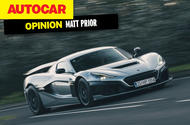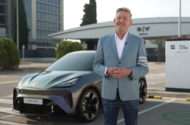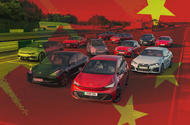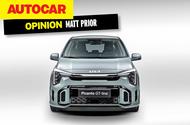Opinion
“Predicting Future Moves of Car Makers is Tougher Than Ever | Giga Gears”
 From JLR re-adopting its ancient 5.0-litre V8 to Rimac ditching EVs, the headlines seem to be changing fast
From JLR re-adopting its ancient 5.0-litre V8 to Rimac ditching EVs, the headlines seem to be changing fast
I think it has finally happened: I can’t keep up with the car world. Sorry. I just suddenly feel overwhelmed.
Where to start? Well, Land Rover announced that it was dropping its straight-six petrol engine from the Defender, which from memory it introduced only about 30 minutes ago, in favour of a V8. Now, don’t misunderstand me: I don’t mind this idea at all. But the V8 in question is JLR’s own supercharged 5.0-litre one, which I thought it had replaced with BMW’s twin-turbocharged 4.4-litre one.
Then Mate Rimac, of electric hypercar fame and sometimes dubbed ‘Europe’s Elon Musk’ by the press (I think I would sue if anyone called me that…), told the Financial Times’ Future of the Car conference that the next Rimac is unlikely to be an EV. Which is weird, because that’s what he’s famous for. But Rimac has sold only 50 of its planned 150 Neveras, see. Which makes me wonder how many Nevera derived Pininfarina Battistas (new special edition out this week) haven’t been sold.
Rimac, who we like a lot here, is also against regulators’ measures to make all cars electric, telling conference attendees that he was “always against” what he called “forced adoption”.
It was quite the week for alarming quotes on this theme. If Ford doesn’t meet zero-emissions sales ratios in the UK, it will restrict supply of ICE vehicles and “sell these vehicles somewhere else”, said Martin Sander, Ford of Europe’s EV chief.
“We can’t push EVs into the market against demand,” said Sander, ruling out paying fines for not meeting minimum zero-emissions car sales quantities (they would be £15,000 per car) or selling off EVs cheaply to make up the numbers.
As we reported recently, Stellantis chief Carlos Tavares has called the UK policy of enforcing a certain percentage of EV sales “terrible”.
Both viewpoints come against a backdrop of China being expected to start dumping EVs here even more cheaply than they are now, which would put the wind up me as a car executive too.
Meanwhile, selling cars in China is giving car makers another headache, because they can’t keep up with the market’s price wars. Nissan has called it “a survival game”, and I’m not sure it will win it when Chinese car makers instruct workers that “a small mistake is not allowed in 2024!” while they’re at the urinals.
Apparently surviving for longer than expected, though, will be the Volkswagen Polo. A relaxation of the proposed Euro 7 emissions regulations, which would have spelled the end of profitability for the Polo, and presumably other affordable cars, should enable it to stay on sale until 2030. The Euro 7 regs have become softer Euro 6e ones, which Volkswagen CEO Thomas Schäfer called “not as crazy”.
However, added Schäfer, what will still “add costs tremendously” are the EU’s General Safety Regulations 2, which mandate monitoring systems – which get turned off, because they’re deeply irritating. “They’re expensive and people don’t want them,” one engineer recently told me.
Whether you’ll be able to buy the Polo you’d like to in the UK, though, of course depends on whether Volkswagen will manage to sell enough EVs alongside them. Fifteen grand per car for not meeting the ZEV mandate is a bit of a burden – unless you’re buying a Bugatti, whose next car will have some electrification but apparently also a new metre-long naturally aspirated V16 engine.
I mean, that sounds great, but blimey, really? It’s 8.3 litres, they say. This is the sort of news that would once have knocked me sideways for a week but which is now barely a passing thought, because a Land Rover gets an old V8, a Chinese factory worker can’t take a leak in peace and it might not be unrealistic to think that, when trying to buy the car they want, people will soon decide “fine, I’ll pay another 15 grand”.
The wild thing is that somehow car makers, stronger of mind and character than me, will navigate all of this and in the midst of it all still manage to produce cars that we want.
Future of Cupra and Seat: Editor’s Letter | Giga Gears
 Since its breakaway in 2018, Cupra has stormed up the sales charts. Not so for Seat, but it still has a future
Since its breakaway in 2018, Cupra has stormed up the sales charts. Not so for Seat, but it still has a future
What’s Spanish for 'meltdown'? That's what Seat chairman Thomas Schäfer caused at the Munich motor show last September when asked about the long-questioned future of the country's national car maker.
In a roundtable interview at which Autocar was present and reported his comments from first, Schäfer said “the future of Seat is Cupra”; investments would go to Cupra and Seat would get a “new role” that would be rooted more in different kinds of e-mobility.
An Australian journalist interviewed Seat and Cupra CEO Wayne Griffiths later that same day, and when the stories were put to him, he said the quotes had been “misunderstood”.
Schäfer himself wrote on LinkedIn something of a love letter to Seat later that week, which began: “Despite inaccurate reports in some media, the Seat brand is stronger than ever”.
Yours truly felt a bit perplexed by the whole situation, as nobody who was in that room felt the original points had been misunderstood or were reported inaccurately.
Nine months later, I at last got a chance to sit down myself with Griffiths for a varied and in-depth interview, which I’m pleased to say did at last clear everything up, as he was unambiguous about the Seat brand's future.
There are no new Seat models currently in the pipeline, only Cupras, which are simply more profitable. Seat’s time will come again when electric cars can be sold profitably at the €20,000 mark as an entry-level brand, but that’s not happening any time soon.
The original quotes undoubtedly created great interest in Spain, and they still get referenced now. Griffiths revealed that even the king of Spain, whose first car was a Seat Ibiza, recently asked him to clarify and reassure him that the brand wasn’t going anywhere.
"There is room for both brands, and one doesn't exclude the other," he said. "Sometimes you have to make priorities. The discussion is now over for most people. I think certainly it is in Spain."
The question over Seat detracts from what should be a positive story around Cupra, although outside of Spain there is some confusion about the fact that 'Seat' not only refers to the Seat brand but also to a group containing the Seat and Cupra brands - and all the manufacturing and R&D facilities, which have been subject to recent €10 billion investments from parent company the Volkswagen Group.
As one brand in the Seat group shrinks and the other grows, it’s hard to say for sure whether sales of one are simply replacing another. Yet what can't be questioned is that Cupra is going to boost profitability and increase margins. The Seat group’s first-quarter results were the best it has ever posted.
Cupra’s positioning feels in a good sweet spot where the likes of Mini and Polestar also operate: cool and classy without being flash or premium.
“I'm confident that we're onto something really big,” said Griffiths. “The cars are good, but the brand is big. We've hit a nerve with a new brand, and if we keep that momentum, I think we can go really far."
So much of Seat's recent history has been about survival and finding its place not only within the car market but also within the Volkswagen Group.
Not so with Cupra, which creates cars that are clearly distinct from Volkswagen and Skoda and arguably now more desirable than several from Audi.
Its ambitions remarkably already extend to breaking into North America – perhaps the world's toughest market – by the end of the decade, complete with bespoke models and local production.
Griffiths himself refers to the scepticism that met Cupra when it was announced as a standalone brand back in 2018, built out of what ostensibly was a trim level for the Seat Ateca back then.
"Everybody said 'let's see', as people had tried it before and nobody had really cracked it. We seem to have cracked it - but I'm not saying it's done yet."
Chinese car companies reclaiming market share from western competitors
 Being a western brand in China is now no longer a licence for success
Being a western brand in China is now no longer a licence for success
Piece by piece, western brands have seen their perceived advantages over Chinese car companies eroded.
As was evident at the recent Beijing motor show, several Chinese car companies are now there or thereabouts with quality cars with international appeal yet that key issue of the quality and appeal of the brands and branding is very much a live argument.
It’s one thing appealing in your home market, quite another when being exported, particularly when so many brands and models are lumped together as ‘Chinese cars’ no matter what they are (including, I’m sure you’ll have noticed, in this piece already).
While the Chinese are still playing catch up on brands, it’s an advantage western car manufacturers are still keen to exploit and talk up, including BMW Group’s recently-appointed brand and sales boss (and ex-China chief) Jochen Goller, who spoke to me at the recent Beijing show.
“My focus at the moment is brand because when you go across the main show floor here, there are an extreme amount of models coming to the markets. It’s overwhelming I think personally.
“Brand is an asset. If curated and strong, it's a real differentiator. We obviously have Mini and Rolls-Royce [in addition to BMW], which I would say are the strongest brands in the world.”
Goller said his focus will be making BMW brands and branding as strong as possible, which in the short term is designed to shore up its position in China where it continues to grow in line with the market unlike many other western brands, but inevitably in the longer term when brands like BMW will be in direct competition with Chinese brands closer to home, and will be at a likely price disadvantage.
“You really have to pay respect to be honest with what is happening when you look at the design and quality” of Chinese cars, said Goller. “These are good cars and the learning curve is very steep.”
The reason why there are so many new Chinese brands popping up all the time is because companies need to have “more than one horse in the race”, as one Geely official told me. “There’s a race to be in the group that makes it to the finishing line” after this expansion and boom era settles down. Profits need to be invested into new brands and products constantly in this race to survive and ultimately thrive.
One of Geely’s new brands is Zeekr, which has been making cars for less than three years but plans to double sales to almost 250,000 units this year on its 2023 performance. Geely design director Stefan Sielaff - formerly of brands including Volkswagen, Audi and Bentley - oversees Zeekr design and described the process of creating a new brand.
“In the beginning, you define the brand, the brand philosophy, the corporate identity, the birthmark, the visual identity. This is all originating in the design department and is very, very important. Then the products and the brand statement are connected with each other, which is a very Western way of thinking. But I have the feeling that the Chinese OEMs are starting to understand this [brands] very well and put a lot of focus on this.”
One thing you cannot create is heritage and a back catalogue of models, another asset western manufacturers will be keen to exploit, not only great cars from their past but also the traits they have. BMW product boss Bernd Korber agreed with Goller that “brand is the best protection” for the future, and “to keep that positioning of being a unique premium brand is the best you can do. I think we can justify that because BMW has clear genetic strengths”.
“Driving performance is an asset, has always been an asset and will be an asset,” he added, a comment that stuck with me later in the day when another BMW executive remarked how pleased he was to hear Chinese journalists ask about dynamic performance of the cars and understood the advantage BMW had here. Whether or not the roads are any good or the cars are driving as hard as they might in Europe, the fact they can be driven that way and are seen as superior is becoming a differentiator Chinese customers understand.
Design is another key differentiator, Goller believes, although the advantage feels less ingrained here. “A lot of cars [in China] look alike. Take the badge off and you cannot distinguish number one from number two. What we do is we have a very unique design language [for BMW] and for Mini and Rolls-Royce as well. We have a competitive advantage and we will keep it.”
Being a western brand in China is now no longer a licence for success, nor is simply being a brand with success back home. You must be a strong one, with a heritage and a clear identity in the way your cars look and drive. Western brands are learning how to compete in China all over again, yet at the same time you know China will be learning plenty about how to take their brands international, too.
Cars’ Angry Look: When Will It End?

The Picanto is tired of being picked on so it’s taken some design steroidsPrior talks design characteristics making cars more aggressive, and wonders if it's all just a fad
I wonder if the mock diffuser at the back of the new Kia Picanto will make it look so sporty and fast that it’ll stop it being tailgated on motorways, as is the fate of so many small cars.
And will its newly beefed-up front end shoo slowcoaches from the outside lane in a way that escapes others of its ilk? Look out mate, one of the Cubes from Terrahawks (ask your dad) is chasing you.
I liked the old Picanto very much, and I expect I’ll like the new one, which got its prices last week ahead of deliveries starting in July. From £15,595, it arrives with a nose that’s so technical and intricate as to be almost post-aggressive.
But aggression, as m’colleague Steve Cropley passingly noted recently, is still very much ‘in’ for new cars. He was a bit sad about that, as I am.
I wonder how much it plays its part in road rage and angst. There is a tendency for us to find faces in inanimate objects. Apparently it’s an evolutionary hangover that conditioned us to spot faces hiding in bushes, either predator or human enemy, and it even primes us to interpret them as wanting to kill us. And now, every time you glance in the mirror, here comes something that appears to be exceedingly cross. Would we all get along better if cars looked more cheerful? Something with a big smile on its chops?
Quite often we’re told a new model has a more aggressive, dynamic stance. There are design-trade tricks to enhance those characteristics: making a car appear wider below the hips with wheel arches that bulge, a high window line and with more frontal area given over to cooling; some gloss black detailing; even some red piping, because red bits are always faster.
But I think the trend towards angrier-looking cars has mostly been accelerated by new lighting technology. Round headlight reflectors, once the only way to project meagre lamp light onto the road, gave a car bright, wide-open ‘eyes’; a cheesy grille could do the rest. Was any car more happy to see you, albeit like a hamster pleased to have stuffed its cheeks, than an Austin-Healey Sprite?
The latest lights can be the narrowest, angriest slits but still be so bright that the UN is investigating how much they dazzle.
It’s still possible to have round headlights, of course, because today lights can be any shape we like. The Alpine A110, Jeep Wrangler and Honda E stick with round, but that shows circularity is largely the preserve of cars that are meant to look retro or classically styled. Round for round’s sake is vanishingly unusual these days.
It seems a shame, but maybe aggression sells. One of the friendliest – or at least most surprised – faces on sale is on the GWM Ora 03 (née Funky Cat), and when did you last see one of those mooching cheerfully down the road? (I grant you its face may not be its biggest stumbling block to widespread UK adoption.) No, grumpiness is very much in at the moment.
Trends obviously do change, though, and people often will overuse a new technology when it first appears before knocking it back to a rather more normal level later. When synthesisers first appeared, their use was prevalent even in heavy rock music. And I heard a story of a late-1970s pub sign that once proudly boasted: ‘Yes! All of our food is microwaved!’
But guitars and griddle plates have found their place again. So perhaps ‘Yes! All of our cars look like they’re coming to beat the living daylights out of you!’ will one day pass too.
Chinese Car Companies Regaining Control from Western Competitors
 Being a western brand in China is now no longer a licence for success
Being a western brand in China is now no longer a licence for success
Piece by piece, western brands have seen their perceived advantages over Chinese car companies eroded.
As was evident at the recent Beijing motor show, several Chinese car companies are now there or thereabouts with quality cars with international appeal yet that key issue of the quality and appeal of the brands and branding is very much a live argument.
It’s one thing appealing in your home market, quite another when being exported, particularly when so many brands and models are lumped together as ‘Chinese cars’ no matter what they are (including, I’m sure you’ll have noticed, in this piece already).
While the Chinese are still playing catch up on brands, it’s an advantage western car manufacturers are still keen to exploit and talk up, including BMW Group’s recently-appointed brand and sales boss (and ex-China chief) Jochen Goller, who spoke to me at the recent Beijing show.
“My focus at the moment is brand because when you go across the main show floor here, there are an extreme amount of models coming to the markets. It’s overwhelming I think personally.
“Brand is an asset. If curated and strong, it's a real differentiator. We obviously have Mini and Rolls-Royce [in addition to BMW], which I would say are the strongest brands in the world.”
Goller said his focus will be making BMW brands and branding as strong as possible, which in the short term is designed to shore up its position in China where it continues to grow in line with the market unlike many other western brands, but inevitably in the longer term when brands like BMW will be in direct competition with Chinese brands closer to home, and will be at a likely price disadvantage.
“You really have to pay respect to be honest with what is happening when you look at the design and quality” of Chinese cars, said Goller. “These are good cars and the learning curve is very steep.”
The reason why there are so many new Chinese brands popping up all the time is because companies need to have “more than one horse in the race”, as one Geely official told me. “There’s a race to be in the group that makes it to the finishing line” after this expansion and boom era settles down. Profits need to be invested into new brands and products constantly in this race to survive and ultimately thrive.
One of Geely’s new brands is Zeekr, which has been making cars for less than three years but plans to double sales to almost 250,000 units this year on its 2023 performance. Geely design director Stefan Sielaff - formerly of brands including Volkswagen, Audi and Bentley - oversees Zeekr design and described the process of creating a new brand.
“In the beginning, you define the brand, the brand philosophy, the corporate identity, the birthmark, the visual identity. This is all originating in the design department and is very, very important. Then the products and the brand statement are connected with each other, which is a very Western way of thinking. But I have the feeling that the Chinese OEMs are starting to understand this [brands] very well and put a lot of focus on this.”
One thing you cannot create is heritage and a back catalogue of models, another asset western manufacturers will be keen to exploit, not only great cars from their past but also the traits they have. BMW product boss Bernd Korber agreed with Goller that “brand is the best protection” for the future, and “to keep that positioning of being a unique premium brand is the best you can do. I think we can justify that because BMW has clear genetic strengths”.
“Driving performance is an asset, has always been an asset and will be an asset,” he added, a comment that stuck with me later in the day when another BMW executive remarked how pleased he was to hear Chinese journalists ask about dynamic performance of the cars and understood the advantage BMW had here. Whether or not the roads are any good or the cars are driving as hard as they might in Europe, the fact they can be driven that way and are seen as superior is becoming a differentiator Chinese customers understand.
Design is another key differentiator, Goller believes, although the advantage feels less ingrained here. “A lot of cars [in China] look alike. Take the badge off and you cannot distinguish number one from number two. What we do is we have a very unique design language [for BMW] and for Mini and Rolls-Royce as well. We have a competitive advantage and we will keep it.”
Being a western brand in China is now no longer a licence for success, nor is simply being a brand with success back home. You must be a strong one, with a heritage and a clear identity in the way your cars look and drive. Western brands are learning how to compete in China all over again, yet at the same time you know China will be learning plenty about how to take their brands international, too.
